Recent Articles
Popular Makes
Body Types
2016 Honda HR-V First Drive and Review
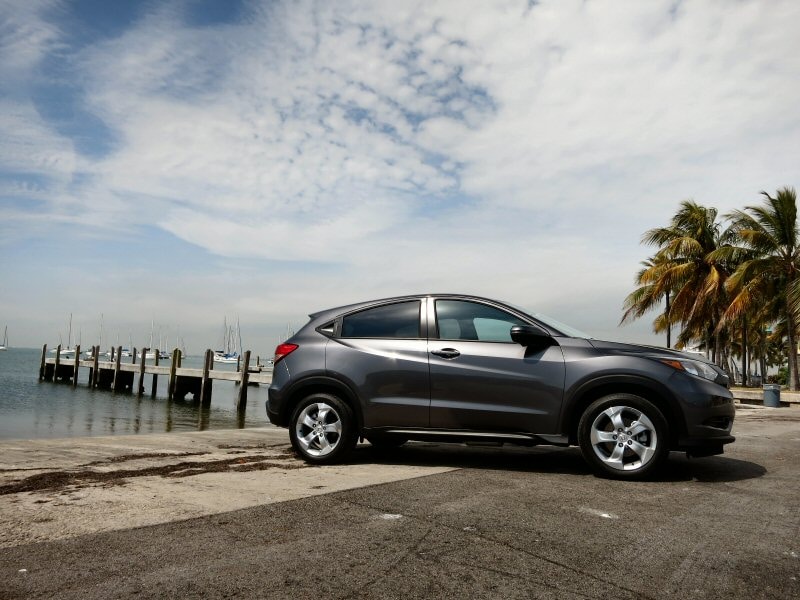
2016 Honda HR-V ・ Photo by Benjamin Hunting
A new piggy-bank has been smashed open by car companies eager to cash in on the latest consumer trends, and it looks a lot like a hatchback on stilts. After years of indifference, automakers are pouring resources into the development of a fresh generation of cute-utes, subcompact crossovers and SUVs designed to pick up where the old guard of entry-level people movers left off when their proportions were plumped up to maximize profits and satisfy space-seeking shoppers.
The 2016 Honda HR-V begs, borrows, and steals from two of the most practical, and popular models in the Japanese brand's line-up - the Honda Fit and the Honda CR-V - but it would be a mistake to assume that this pint-sized crossover is some cynical cash-grab Frankenstein's monster rushed into production to capitalize on the current zeitgeist. As I discovered after spending the day tooling around Miami, Florida behind the wheel of the all-new Honda, the HR-V is a fully-realized concept that rises above the sum of its parts to present a legitimate challenge to similarly-useful entry-level options like the Kia Soul, the Jeep Renegade, and the upcoming Mazda CX-3.
Models and Prices
The 2016 Honda HR-V is available in three distinct models - LX, EX, and EX-L Navi - and each one offers the option of all-wheel. A continuously-variable automatic transmission is available across the range, and is in fact required when selecting all-wheel drive (and standard with top of the line models), but LX and EX editions of the crossover can also be had with a six-speed manual gearbox.
The base Honda HR-V LX (MSRP $19,115) offers a five-inch LCD infotainment screen, 17-inch alloy rims, a rearview camera, air conditioning, cruise control, Bluetooth connectivity, power windows and door locks, the Magic Seat cargo management feature, a CD player, a USB port, and hill start assistance. Moving up to the HR-V EX (MSRP $21,165) installs heated seats up front, a push button start system with keyless entry, a moonroof, fog lights, an auto feature for the headlights, an expanded-angle rearview camera, the LaneWatch safety system, the ability to display text messages, an upgraded audio system (with a larger 7-inch touchscreen interface and the HondaLink app system), more bright work throughout the cabin, an additional USB port, an HDMI input, and automatic climate control. The best-equipped version of the Honda crossover, the EX-L Navi (MSRP $25,590), provides the eponymous navigation system, along with HD and satellite radio and leather upholstery on the seats, steering wheel, shift knob, and door panels (there's also an auto-dimming rearview mirror).

Photo by Benjamin Hunting
Design
The 2016 Honda HR-V is an all-new design.
Some automakers - such as Nissan with the Juke and Jeep with the Renegade - have approached the subcompact crossover segment as a palette for more unusual designs. The 2016 Honda HR-V has instead been cast from a very similar mold as the larger CR-V, which means a pleasing, although semi-anonymous look that makes use of a broad front fascia and muscular character lines along the side that link its haunches to its bulging front fenders. The vehicle also sits just high enough off of the ground to prevent you from easily confusing it with a common hatchback.
From the rear, the HR-V is less successful at carving out its own identity, as the hatch and light combination (with LEDs standard on all models) don't stand out especially when compared to other subcompact SUVs. Still, the Honda's inoffensive character plays perfectly to the company's existing customer base and isn't bland to the point where it would alienate potential newcomers to the brand. The decision to afford all versions of the HR-V with classy alloy wheels is a nice touch, as even on the affordable LX model, you avoid any of the stripped-down feel that steelies can sometimes impact.
The Honda HR-V's interior trappings take simplicity in a direction that's a little too stark for my tastes. Particularly unusual for a vehicle that intends to appeal to younger buyers, there's little flash to be found when sitting inside the utility-focus crossover. Even the mid-tier EX's extra chrome doesn't do much to break up the black and gray plastics of the vehicle's passenger compartment, and while the soft-touch fabric door panels were a nice touch, they won't age all that well as they slowly accumulate dust and dirt over a lifetime of use. The glass-touch panels for the automatic climate controls and the LCD touchscreen are similarly featureless, and as the latter isn't recessed into the dash, it's easy for the display to be washed out by the sun - a problem often encountered when dealing with Miami's relentless solar torrent.
I did like the unique single-bar heating/cooling vents that stretch across the dashboard immediately in front of the passenger, however, in addition to the way the glass speedometer binnacle glowed green to reward my eco-friendly driving habits. Each of these features stood out from the plainness of the vehicle's interior.
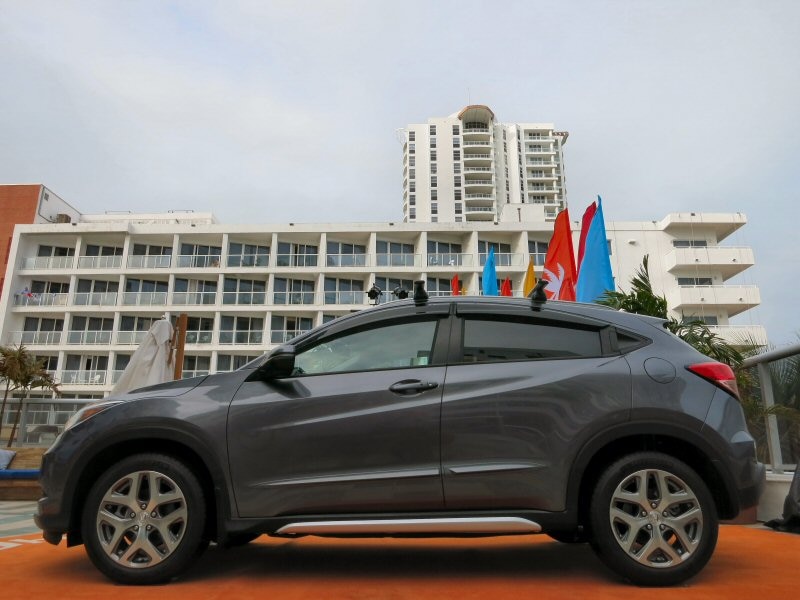
Photo by Benjamin Hunting
Comfort and Cargo
What’s New:
The 2016 Honda HR-V is an all-new design.
Packaging is perhaps the single most important aspect of the 2016 Honda HR-V. Specifically, this is a vehicle that is 10 inches shorter than the CR-V overall, and yet is within one inch of the larger crossover's wheelbase. This translates into an appreciable amount of interior space that is made even more useful by the inclusion of the same Magic Seat system found in the Honda Fit. The Magic Seat second row folds forward to reveal up to 58.8 cubic feet of total storage room (with a touch less available in all-wheel drive models), and it can also lift up its seat cushion to facilitate the transportation of taller items that can't be tipped. The 60/40 split of the Magic Seat feature can be combined with a fold-flat front passenger seat that allows the HR-V to swallow even over-long gear that you don't want to strap to the vehicle's available roof rails, and the load floor is low enough that it's hard to imagine anyone having trouble filling the crossover to the brim.
I think that the Honda HR-V's immense versatility in the cargo department will appeal to a wide swath of younger shoppers who want something taller than a hatchback to haul whatever it is they've got lurking in their condo storage lockers to the mountain, the ski hill, or the swap meet on the weekend. Passenger room is also fairly good behind the two front spots, but I'm not sure if families will be as attracted to the HR-V as they are to the CR-V. Call it a question of perception versus practical reality.
One odd aspect of the Honda HR-V is its unusual seating position for the driver and right-seat passenger. Honda touts the design as offering a view out the front windshield that is four inches higher than 'average' as compared to a similarly-sized hatchback, but I found it impossible to lower the seat enough to get truly comfortable behind the wheel. This was an issue I shared with my co-pilot for the day, and neither of us crest the six-foot mark. There's also not a lot of storage room in the front of the crossover - you get a small locker under the armrest, a couple of door pockets, and a pass-through cubby at the underneath the console where the USB and HDMI outlets are. You'll be spreading your gear all over the HR-V's interior on shorter trips, with phones, purses, and drinks all jockeying for position.
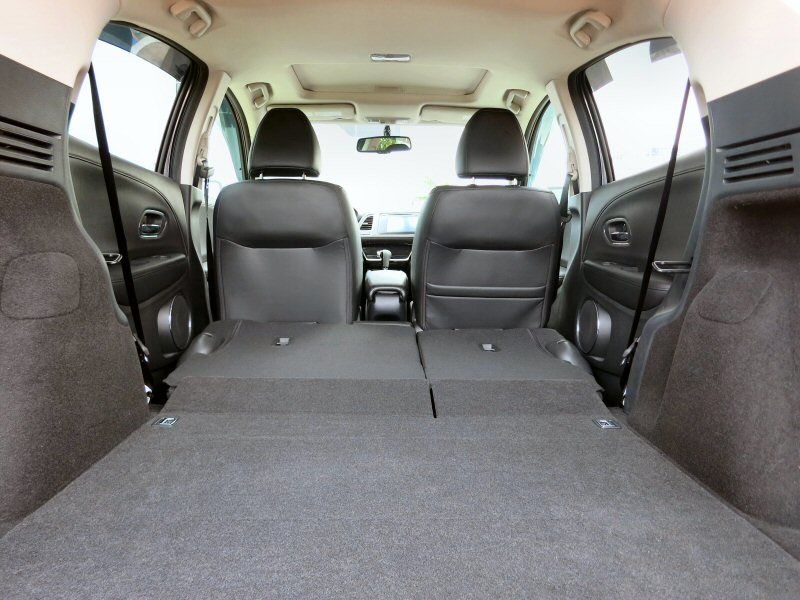
Photo by Benjamin Hunting
Features and Controls
What’s New:
The 2016 Honda HR-V is an all-new design.
I've already mentioned the effects of the sun on the 2016 Honda HR-V's glass-panel control surface for climate control as well as its infotainment screen, but it's worth mentioning again because if you order above the LX trim these will be the interfaces you are stuck with. It's not so much a bad design as it is one that's marred by the decision to ignore the existence of sunlight. This is especially true of the climate panel, which uses white LEDs to indicate temperature and fan speed, further exacerbating the problem. There are no knobs or dials to grab onto for EX or EX-L Navi shoppers, so if you're wearing gloves in the winter you'll have a hard, if not impossible time adjusting the heater or switching radio stations past the limited capabilities of the steering wheel controls.
Ford stands out as an example of a company that was forced to back away from capacitive touch controls and offer a more balanced hard button / touchscreen design in its cabins, due in large part to owner outcry. Honda might be heading down the same road with the HR-V's touch-only setup.

Photo by Benjamin Hunting
Safety and Ratings
The HR-V gains the same LaneWatch blind spot monitoring feature offered in other Honda vehicles.
The 2016 Honda HR-V comes equipped with side curtain airbags, front side impact airbags, and dual forward airbags free of charge, along with electronic stability control and traction control. Also present is an electric power steering system that can work with the crossover's stability control program to actually steer out of a skid, or stabilize the vehicle during heavy braking. I didn't have the chance to sample any extreme conditions while piloting the HR-V, so I can't comment on how intrusive this system is in a real-world situation.
If you pay for the EX or EX-L Navi editions of the HR-V you'll also get Honda's LaneWatch feature, which automatically activates a camera on the right side of the vehicle when you trip the right blinker. The camera's video image is displayed on the seven-inch LCD screen on the HR-V's center console, theoretically giving you a full view of the area immediately beside the car and helping you avoid a potential collision. In actual practice, I found LaneWatch to be distracting, pulling my eyes from the road to the screen every single time I used my indicator. It'll also takes over the infotainment display even if your passenger is in the middle of using the sound system, which I am sure will never result in road trip discord. LaneWatch is the only piece of active safety equipment available with the HR-V; you can't get lane departure or forward collision warning with the SUV, nor is it possible to benefit from a blind spot monitoring system that scans both sides of the Honda.
2016 Honda HR-V Crash Test Ratings: Neither the NHTSA nor the IIHS has crash tested the Honda HR-V.
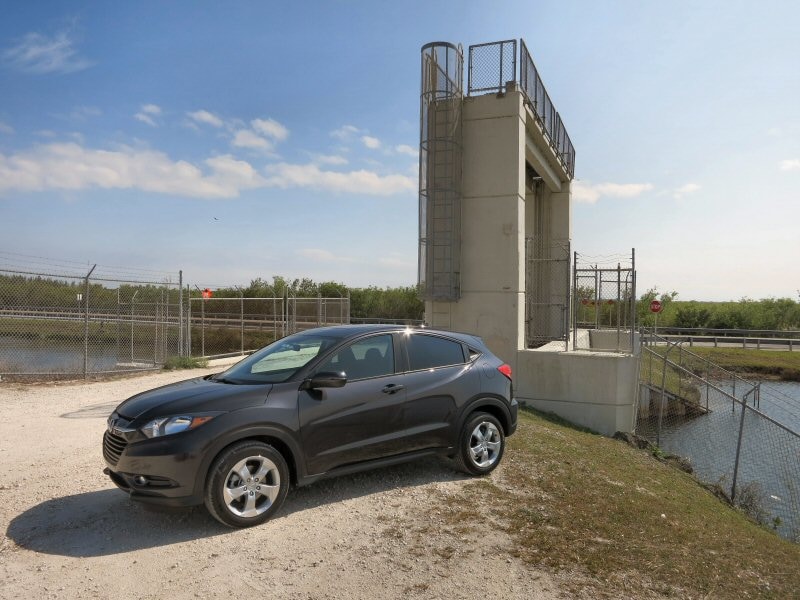
Photo by Benjamin Hunting
Engines and Fuel Economy
What’s New:
The 2016 Honda HR-V features a 1.8-liter, four-cylinder engine. A choice of manual and CVT gearboxes is offered. All-wheel drive is optional.
The 2016 Honda HR-V might share part of its platform with the smaller Fit, but it's over nine inches longer overall and also carries the extra weight of an optional all-wheel drive system. It was clear that the Honda hatchback's 1.5-liter four-cylinder engine wasn't going to cut it hauling around the increased bulk of the crossover, so the HR-V instead benefits from a 1.8-liter four-cylinder unit lifted from the Civic.
Rated to produce 141 horsepower and 127 lb-ft of torque, it's got 11 additional ponies and 13 more lb-ft of twist than the Fit's smaller mill. Surprisingly, fuel mileage for the bigger, more robust HR-V is only a few miles per gallon less when compared against the subcompact Honda hatchback: the crossover returns 28-mpg city and 35-mpg highway when found with two-wheel drive and a continuously-variable automatic transmission (all-wheel drive and six-speed manual editions of the HR-V are not quite as frugal).
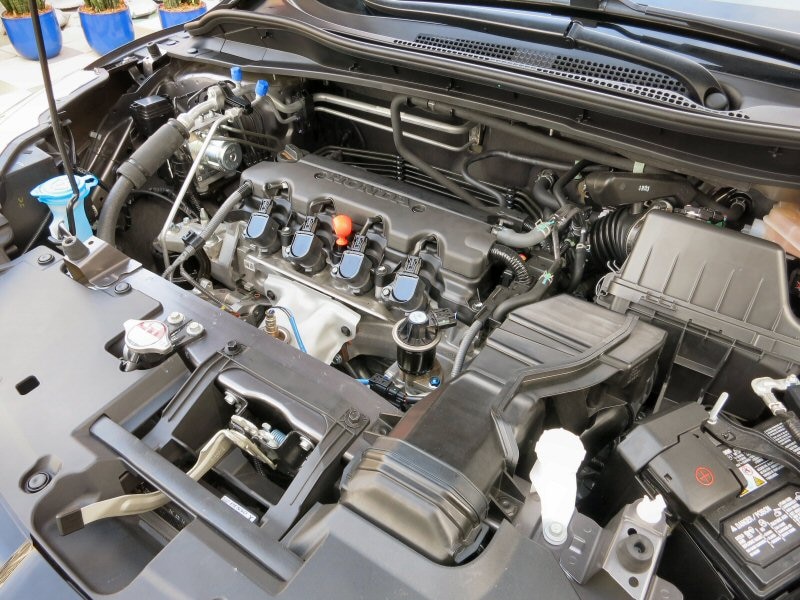
Photo by Benjamin Hunting
Driving Impressions
The 2016 Honda HR-V is focused primarily on two things: practicality and efficiency. As a result, on the road it doesn't try too hard to make a connection between the driver and the pavement. Rather, the HR-V's chassis insulates instead of communicates, which is perfectly acceptable for an entry-level crossover. Around town the Honda felt compliant and comfortable, and it was only on the highway that I noticed a slight wandering from the HR-V's steering.
The 1.8-liter motor that comes standard with the Honda is also adequate for the task at hand. While I didn’t have the chance to drive a fully-laden HR-V, there's enough pluck to be wrung out of the four-cylinder to get you up to speed quick enough in most situations. The manual transmission in the crossover felt quicker than the CVT, but Honda engineers assured me that in actual testing the automatic is marginally more fleet of foot. Backing up that assertion is the autobox's Sport mode, which significantly improves throttle response and comes closer to mimicking the direct feel of the self-shifter. Steering wheel mounted paddles are included with the CVT, and allow access to seven 'virtual' ratios, but given the rather staid nature of the drivetrain, I preferred to let the transmission's computerized brain do the thinking for me.
One thing to keep in mind, regardless of which transmission you choose, the Honda HR-V isn't the quietest crossover I've ever driven. When you step down on the gas and peg the throttle, there's a buzz from under the hood that's immediately noticeable, especially when calling on passing power on the freeway. At its price point, and displacement, one can't expect too much refinement or Buick-levels of sound insulation, but the HR-V does not go quietly on its quest to eclipse 60-mph. Also, it's not reasonable to expect the Honda crossover to handle anything other than rutted roads even with all-wheel drive installed. The system, which directs torque to the rear axles when wheel spin is detected up front, is largely transparent in operation and intended to handle wet, snowy, or icy conditions, and is in fact adapted almost unchanged from the larger CR-V.
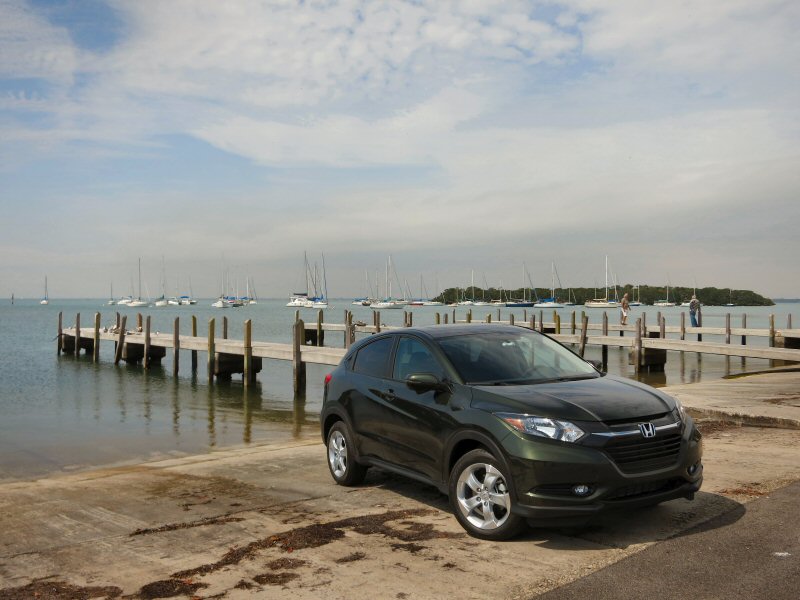
Photo by Benjamin Hunting
Final Thoughts
The 2016 Honda HR-V isn't intended to tackle off-road trails like the Renegade, or offer above-average handling and peppy acceleration like the Juke. Instead, the HR-V stands in as your ever-reliable buddy who will help you move, drive you home through a snowstorm, and keep you comfortable and entertained on a long drive. Honda has created yet another transportation tool for its impressive portfolio of vehicles that slots perfectly into a wide range of lifestyles, and while the HR-V's driving experience might be devoid of passion that doesn't mean it's not perfectly tailored for its target market.
The HR-V is a supremely useful vehicle, and its hard to overstate its versatility when it comes to juggling cargo, both human and otherwise. Also notable is its small form factor that will be immediately appreciated by anyone facing limited parking space or regularly brutal city traffic. Of even broader appeal is its affordable pricing and its ability to post as much as 31-mpg in combined driving. Honda has had subcompact practicality all figured out for years with the Fit, and the ability to port that knowledge into an entry-level crossover like the 2016 HR-V should translate into major success.
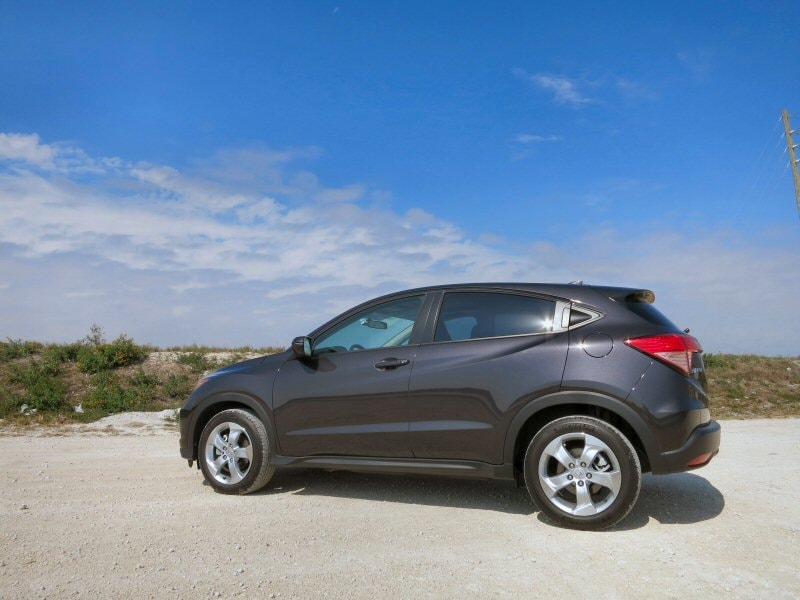
Photo by Benjamin Hunting
Pros and Cons
Pros:
Extremely useful despite its small size Fuel efficient Affordable Conservatively stylish Available all-wheel drive
Cons:
Four-cylinder engine is adequate, but nothing more Interior style is less expressive than the sheet metal would suggest EX and EX-L Navi trims offer no actual knobs or dials to use during winter weather for heat controls or infotainment Dashboard displays wash out easily in the sun
American Honda Motor Company supplied the vehicle for this review
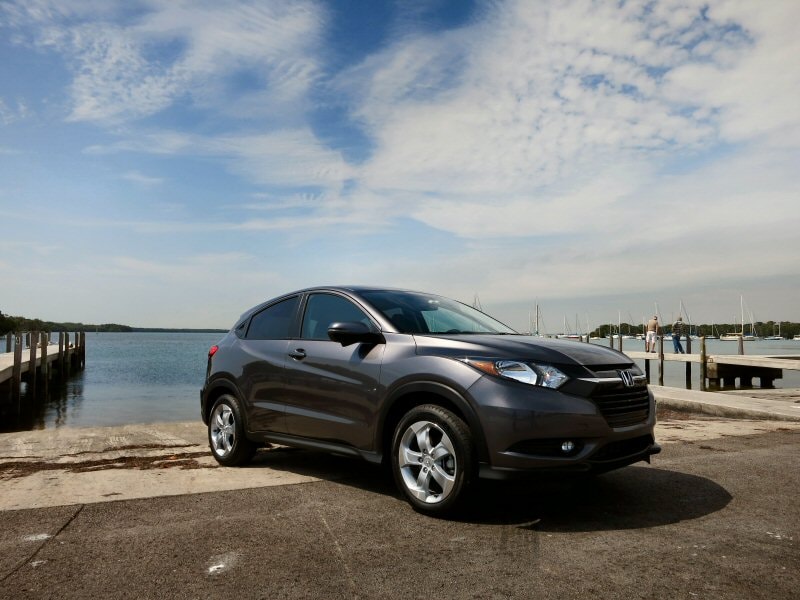
Photo by Benjamin Hunting